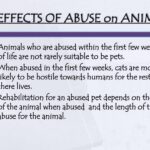When pondering the plight of animals, one might ask, “What actually constitutes animal cruelty, and under what circumstances does the law intervene?” The answer lies in a complex interplay of societal norms, statutory definitions, and prosecutorial discretion. Understanding the key legal thresholds that trigger prosecution for animal cruelty is essential for both advocates and the general public to grasp the gravity of this issue.
Animal cruelty can be broadly categorized into two types: active and passive. Active cruelty involves direct harm, such as beating, torturing, or otherwise causing injury to an animal. Passive cruelty, on the other hand, encompasses neglectful behaviors that result in suffering or injury over time, such as failing to provide adequate food, water, shelter, or veterinary care. The varying nature of these offenses introduces complexity into legal interpretations and the subsequent enforcement of animal welfare laws.
To effectively prosecute animal cruelty, legal systems typically require a demonstrable threshold of intent or recklessness. This means that to secure a conviction, prosecutors must often establish that the perpetrator acted purposely or with a blatant disregard for the animal’s well-being. A mere lack of knowledge about proper animal care may not be sufficient for legal repercussions unless it can be shown that the individual had been willfully ignorant or had repeatedly ignored prior warnings.
Generally, the legal statutes surrounding animal cruelty differ from state to state. Some jurisdictions classify animal cruelty as a misdemeanor, while others may elevate certain egregious acts to felony status. For example, in states such as California, the intentional killing or torture of an animal may result in felony charges, while unintentional harm caused by negligence could result in lesser charges. This disparity can pose challenges for enforcement, as a behavior deemed cruel in one state might be treated more leniently in another.
Enforcement agencies, whether they consist of local animal control or dedicated humane organizations, play a critical role in the prosecution of animal cruelty cases. Often, the initial step in the judicial process is filing a complaint after an investigation based on reported suspicions of cruelty. Investigators may gather evidence through various means, including witness testimonies and photographic documentation. A thorough understanding of the legal requirements for evidence admissibility is vital during this stage.
Moreover, public awareness and advocacy can significantly influence the prosecution of animal cruelty cases. High-profile cases often evoke substantial media attention, resulting in increased pressure on law enforcement and prosecutors to take action. This phenomenon raises intriguing questions about the role of societal attitudes toward animals in shaping legal outcomes. Are we more inclined to respond to egregious acts of cruelty that attract media coverage, while neglect cases typically receive scant attention?
Proving cruelty often relies on expert testimony. Veterinarians, animal behaviorists, and other professionals may be called to articulate the suffering experienced by an animal, bridging the gap between layman’s intuition and legal requirements for proving harm. Evidence of emotional distress may also be introduced, highlighting the sentience of animals and the psychological ramifications of their treatment.
Once cases reach the courtroom, the prosecutorial burden intensifies. Prosecutors must adeptly navigate the legal landscape, often contending with defenses such as lack of intent, claims of self-defense, or challenging the definitions of cruelty themselves. The defense may argue circumstances beyond the accused’s control, such as economic hardship preventing proper animal care. In such instances, juries are called upon to weigh the nuances of each case—an exercise fraught with moral implications.
One must also consider the role of rehabilitation versus punishment in the context of animal cruelty prosecutions. Courts may opt for restorative approaches aimed at educating offenders about proper animal care practices rather than imposing heavy penalties. This paradigm shift reflects an evolving understanding of animal welfare and the recognition that ignorance is not always a criminal intent. It introduces a fascinating juxtaposition in legal philosophy: Can compassion for a human’s situation coexist with accountability for their actions toward animals?
The rise of animal rights organizations has further cultivated a climate of advocacy, leading to state-level legislative changes and the introduction of new laws aimed at reducing animal suffering. Initiatives pushing for stronger animal welfare protections have sparked fierce debate within legislative halls. Lobbying efforts from both animal welfare groups and agricultural interests continue to shape the contours of animal cruelty laws and their enforcement.
As our understanding of animal sentience continues to evolve, so too must our legal frameworks. The disparity in animal cruelty laws presents an ongoing challenge, highlighting the necessity for a more harmonized approach to safeguarding animals. This becomes especially urgent when we consider the prevalence of animal-related crimes, as indicators show a correlation between animal cruelty and broader societal violence.
Ultimately, as societal awareness of animal welfare burgeons, so too does the imperative for effective legal action against cruelty. The intersections of law, ethics, and societal norms dictate that we continually reassess our legislative measures. By articulating clear definitions, establishing comprehensive protections, and ensuring diligent enforcement, we can better secure the welfare of the voiceless creatures who share our world. The journey is far from over, but it is one worth undertaking for the sake of our fellow beings.







